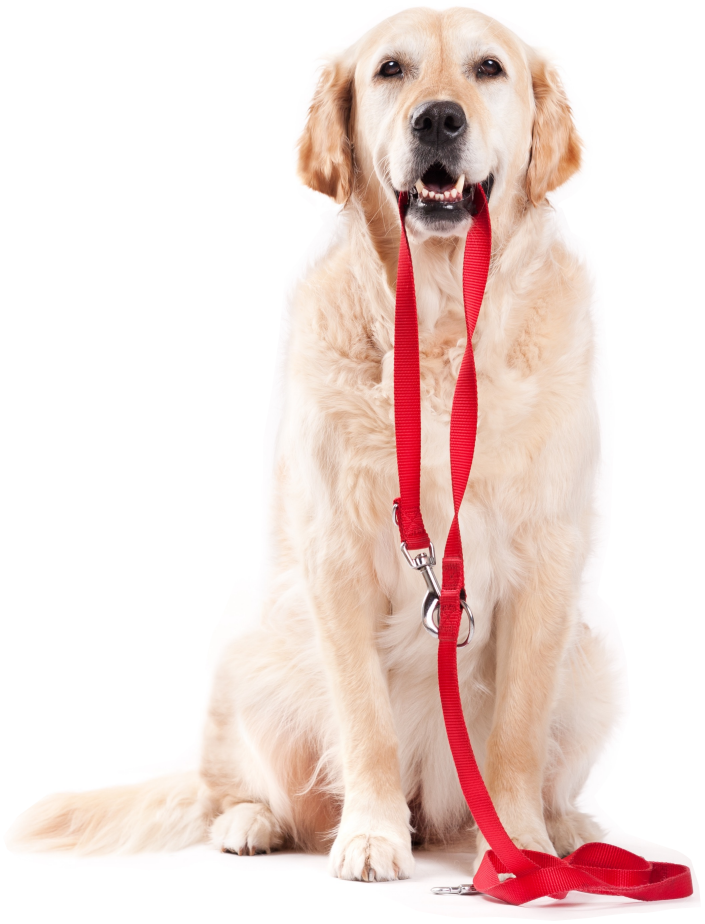Cranial cruciate ligament tears, also known as anterior cruciate ligament (ACL) tears, are the most prevalent orthopedic condition seen in dogs. The cause of this ever-increasing problem remains elusive, although chronic biomechanical wear associated with the canine tibial plateau slope seems to be the common denominator. Unlike humans, canine ACL tears are typically a chronic degenerative process rather than acute traumatic injury. Left untreated, canine ACL tears often lead to a high incidence opposite side tearing, meniscal pathology and osteoarthritis.
All dog breeds develop ACL tears. Limping and sitting to the side are the main clinical signs. Tentative diagnosis is based on palpation and radiographs. Definitive diagnosis should always be confirmed by an arthroscopic examination.

Canine ACL tears are the result of chronic biomechanical wear rather than acute trauma. Unlike humans, dogs have a sloping tibial plateau (figure 1). Because of the canine sloping tibial plateau, the femur slides down and back the sloping tibial plateau during weight bearing resulting in biomechanical stress and ultimately degeneration and tearing of the ACL (figure 2). In dogs, the ACL almost always tears or degenerates gradually over time due to this chronic biomechanical stress (figure 3). This degenerative process is well documented via arthroscopy (figure 4).
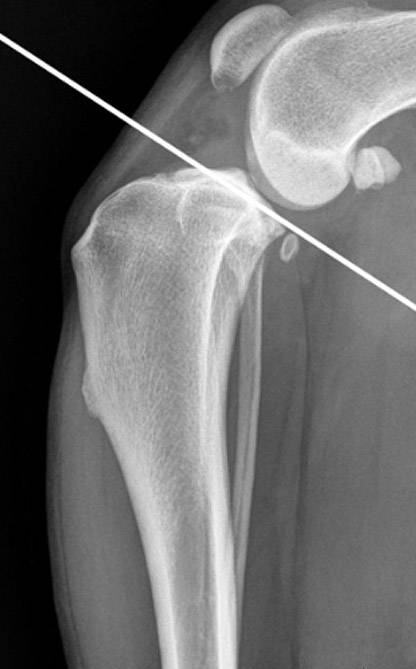
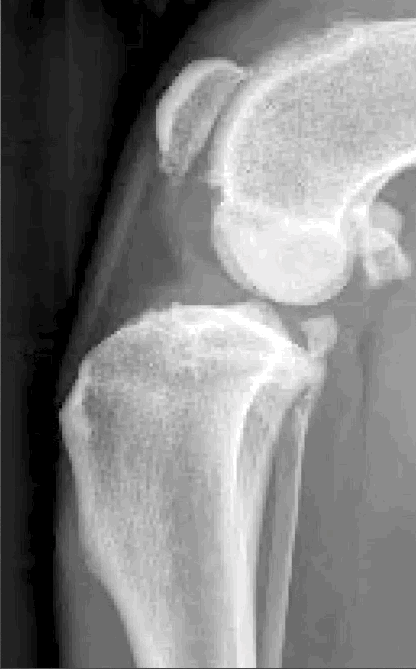
The clinical signs seen in dogs with ACL tears are quite variable, from subtle lameness to complete non-weight bearing. Subtle lameness and “off-weighting” the leg are often seen early in the degenerative, tearing process. However, many dogs have persistent, moderate to severe lameness. The degree of lameness is influenced by the progressive osteoarthritis seen with ACL pathology, degree of tearing and concurrent meniscal tears.
Almost all dogs with ACL problems sit to the side, even when sitting for a treat. Sometimes the lameness comes on quickly but often it’s a gradual progressive problem. It is not uncommon for the problem to wax and wane for weeks or even months.
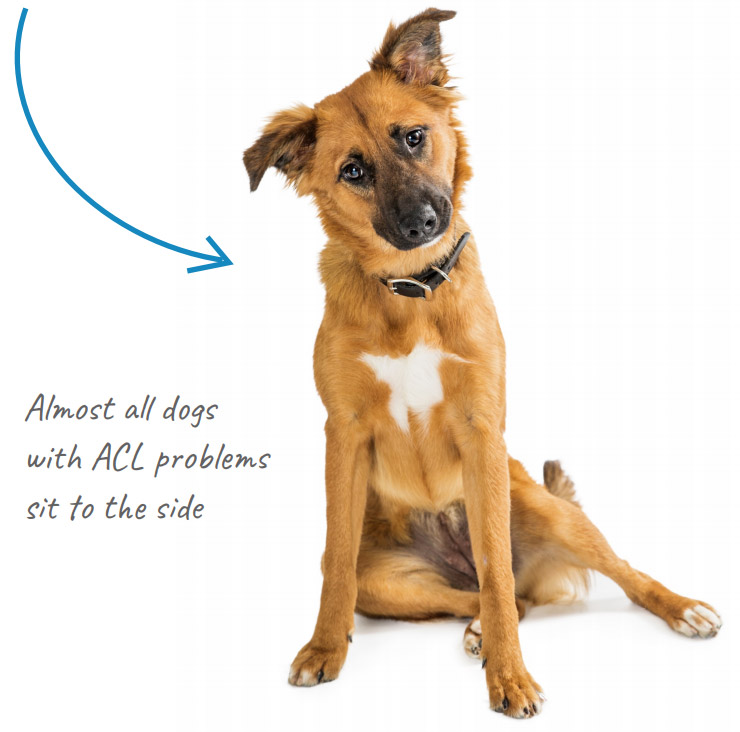
Palpation is accurate in diagnosing canine ACL tears in dogs with acute complete tears. However, palpation alone is inaccurate in nearly half of all dogs with ACL problems due to gradual, incomplete tearing and the ensuing scar tissue that develops as the ligament degenerates. The formation of scar tissue is also termed “joint fibrosis” and while this tissue does help stabilize the joint, it also decreases range of motion an is a source of chronic pain.
Radiographs (X-rays) are helpful in ACL tear diagnosis. In some cases, the side view X-ray will actually show the displaced femur. Other radiographic signs commonly seen in dogs with ACL tears include joint effusion and bone spur (osteophyte) formation.
Definitive diagnosis of canine ACL tears should be made via an arthroscopic examination at the onset of surgery. Arthroscopy is extremely accurate and minimally invasive. In our opinion no open surgical procedure should be performed prior to obtaining an accurate, non-invasive arthroscopic diagnosis.
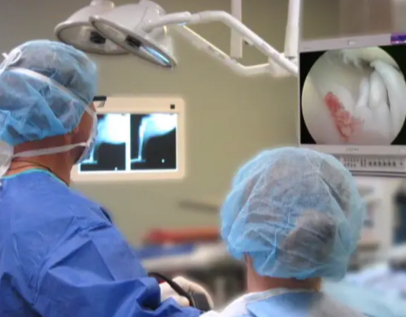
Tibial Plateau Leveling Osteotomy (TPLO) is by far, the technique that the majority of veterinary surgeons agree yields the most consistent, long-term positive results in dogs with ACL tears. Colorado Canine Orthopedics has performed tens of thousands of TPLO surgeries over the past 20 years.
Non-surgical treatments are usually unsuccessful in canine ACL tears due to chronic biomechanical stress related to the canine stifle (knee) anatomy; specifically, the sloping tibial plateau. Custom splinting has been advocated by folks that make and market these devises, however, in our opinion (and experiences from seeing these patients), this option is expensive, frustrating, and ineffective. Furthermore, the inability of splinting to provide stability often results in subsequent meniscal tearing. Regenerative medicine specifically stem cell therapy and platelet rich plasma (PRP) have also been used unsuccessfully to treat ACL tears. Colorado Canine Orthopedics is a nationally known authority in veterinary regenerative medicine and in our opinion the use of these treatments are ineffective and lack of scientific supportive evidence.
Surgical options are broken down into replacement techniques and biomechanical repairs. Fishing line and like materials, have been used to replace torn ACLs for decades. Newer, more sophisticated materials are currently available but consistent long-term security is still questionable. All surgeons at CCOR have performed replacement techniques, for one reason or another, and in our experience replacement techniques often fail. Recent studies have shown replacement techniques do not provide adequate joint stability and are the least effective surgical method in restoration of normal joint biomechanics.
Biomechanical repairs address the underlying biomechanical cause of canine ACL tears and the TPLO procedure is the most widely performed and accepted. Sophisticated fluoroscopic (video X-ray) studies have examined dogs with normal stifle joints, dogs with ACL tears and dogs that have undergone current surgical techniques and found the TPLO is the best procedure in restoring normal joint biomechanics.
